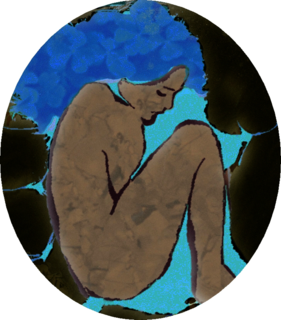
Aztec mythology is the body or collection of myths of Aztec civilization of Central Mexico. The Aztecs were Nahuatl-speaking groups living in central Mexico and much of their mythology is similar to that of other Mesoamerican cultures. According to legend, the various groups who were to become the Aztecs arrived from the north into the Anahuac valley around Lake Texcoco. The location of this valley and lake of destination is clear – it is the heart of modern Mexico City – but little can be known with certainty about the origin of the Aztec. There are different accounts of their origin. In the myth the ancestors of the Mexica/Aztec came from a place in the north called Aztlan, the last of seven nahuatlacas to make the journey southward, hence their name "Azteca." Other accounts cite their origin in Chicomoztoc, "the place of the seven caves," or at Tamoanchan.

The Polynesian narrative or Polynesian mythology encompasses the oral traditions of the people of Polynesia, a grouping of Central and South Pacific Ocean island archipelagos in the Polynesian Triangle together with the scattered cultures known as the Polynesian outliers. Polynesians speak languages that descend from a language reconstructed as Proto-Polynesian that was probably spoken in the Tonga - Samoa area around 1000 BC.
In Māori mythology, Rongo or Rongo-mā-Tāne is a major god (atua) of cultivated plants, especially kumara, a vital crop. Other crops cultivated by Māori in traditional times included taro, yams (uwhi), cordyline (tī), and gourds (hue). Because of their tropical origin, most of these crops were difficult to grow except in the far north of the North Island, hence the importance of Rongo in New Zealand.

In Māori mythology, Tāne is the god of forests and of birds, and the son of Ranginui and Papatūanuku, the sky father and the earth mother, who used to lie in a tight embrace where their many children lived in the darkness between them.

In Māori mythology, Tangaroa is one of the great gods, the god of the sea. He is a son of Ranginui and Papatūānuku, Sky and Earth. After he joins his brothers Rongo, Tūmatauenga, Haumia, and Tāne in the forcible separation of their parents, he is attacked by his brother Tāwhirimātea, the god of storms, and forced to hide in the sea. Tangaroa is the father of many sea creatures. Tangaroa's son, Punga, has two children, Ikatere, the ancestor of fish, and Tū-te-wehiwehi, the ancestor of reptiles. Terrified by Tāwhirimātea's onslaught, the fish seek shelter in the sea, and the reptiles in the forests. Ever since, Tangaroa has held a grudge with Tāne, the god of forests, because he offers refuge to his runaway children.

Hine-nui-te-pō is a goddess of night and death and the ruler of the underworld in Māori mythology. She is the daughter of Tane Mahuta and Hine-ahuone. It is believed among tangata whenua that the color red in the sky comes from her.
In mythology of Mangaia and the southern Cook Islands, Vatea is the father of gods and men. His mother is Varima-te-takere, who lives deep in Avaiki, the underworld. She plucks off a piece from her right side and it becomes Vatea or Avatea.

In Hawaiian mythology, Laka is the name of two different popular heroes from Polynesian mythology.. Lengthy legends of their exploits extend throughout the islands, and the kings of Tahiti and Hawaiʻi claimed them as their ancestors.

In Māori mythology, Rūaumoko is the god of earthquakes, volcanoes and seasons. He is the youngest son of Ranginui and Papatūānuku.

Nut, also known by various other transcriptions, is the goddess of the sky in the Ennead of ancient Egyptian religion. She was seen as a star-covered nude woman arching over the earth, or as a cow.

In Mesopotamian mythology, Ereshkigal was the goddess of Kur, the land of the dead or underworld in Sumerian mythology. In later East Semitic myths she was said to rule Irkalla alongside her husband Nergal. Sometimes her name is given as Irkalla, similar to the way the name Hades was used in Greek mythology for both the underworld and its ruler, and sometimes it is given as Ninkigal, lit. "Lady of the Great Earth".

Korean mythology are the stories passed down by word of mouth over thousands of years on the Korean Peninsula and only written down in historical times. These stories serve as creation myths about the world and origin myths about nature or the social world. Korean myths are often localized and concern specific villages or clans.

Hittite mythology and Hittite religion were the religious beliefs and practices of the Hittites, who created an empire centered in what is now Turkey from c. 1600 BCE to 1180 BCE.
Micronesian mythology comprises the traditional belief systems of the people of Micronesia. There is no single belief system in the islands of Micronesia, as each island region has its own mythological beings.

Sumerian religion was the religion practiced and adhered to by the people of Sumer, the first literate civilization of ancient Mesopotamia. The Sumerians regarded their divinities as responsible for all matters pertaining to the natural and social orders.

The mythology of Indonesia is very diverse, the Indonesian people consisting of hundreds of ethnic groups, each with their own myths and legends that explain the origin of their people, the tales of their ancestors and the demons or deities in their belief systems. The tendency to syncretize by overlying older traditions with newer foreign ideas has occurred. For example, the older ancestral mythology might be merged with foreign mythology, such as Hindu, Islam, or Christian biblical mythology.
















